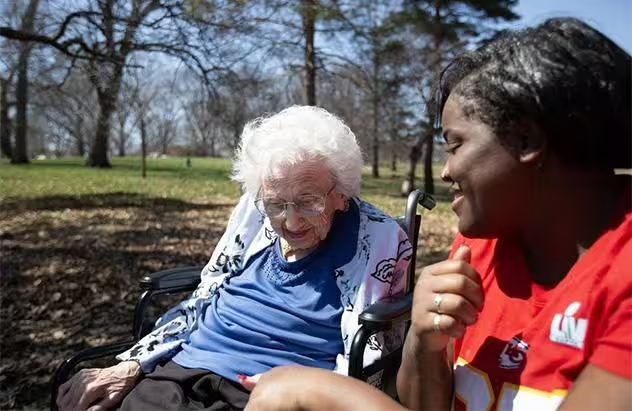Age-Old Questions: A Revealing Look at the State of Aging
Top Three Ways to Finance Extended Care
Clip | 4m 36sVideo has Closed Captions
Certified Financial Planner™ Jamie Bosse examines key ways to finance long-term care.
Projections estimate that 70 percent of people over the age of 65 will require some sort of ongoing support to maintain a good quality of life and that care comes at a cost. Jamie Bosse, Certified Financial Planner™ and member of Kansas City's Financial Planning Association, examines the top three ways to pay for long-term care: long-term care insurance, government programs and personal savings.
Problems playing video? | Closed Captioning Feedback
Problems playing video? | Closed Captioning Feedback
Age-Old Questions: A Revealing Look at the State of Aging is a local public television program presented by Kansas City PBS
Support for the Age-Old Questions reporting package was provided by William T. Kemper Foundation, Commerce Bank, Trustee; Additional support provided by Husch Blackwell.
Age-Old Questions: A Revealing Look at the State of Aging
Top Three Ways to Finance Extended Care
Clip | 4m 36sVideo has Closed Captions
Projections estimate that 70 percent of people over the age of 65 will require some sort of ongoing support to maintain a good quality of life and that care comes at a cost. Jamie Bosse, Certified Financial Planner™ and member of Kansas City's Financial Planning Association, examines the top three ways to pay for long-term care: long-term care insurance, government programs and personal savings.
Problems playing video? | Closed Captioning Feedback
How to Watch Age-Old Questions: A Revealing Look at the State of Aging
Age-Old Questions: A Revealing Look at the State of Aging is available to stream on pbs.org and the free PBS App, available on iPhone, Apple TV, Android TV, Android smartphones, Amazon Fire TV, Amazon Fire Tablet, Roku, Samsung Smart TV, and Vizio.

Age-Old Questions
Explore the complexities of retirement and elder care and submit your questions about caring for our aging population.(soft upbeat music) - Hi, I'm Jamie, certified financial planner and member of Kansas City's Financial Planning Association.
Here to help to make sure you and your loved ones are ready to make decisions about long-term care.
First off, what is long-term care?
It's all about helping people who need ongoing support with everyday things because they are aging or have medical conditions that limit daily functions.
It includes services provided at home, in assisted living places, or nursing homes, to make sure people have good quality of life when family and friends can't do it all.
It is projected that seven out 10 folks who are over 65 today will need some type of help with long-term care.
So really the question is not whether you'll need it, but how you'll pay for it.
In Missouri, the cost of long-term care can average around $90 a day, and that figure increases to about $165 a day in Kansas.
Even the premiums to get long-term care insurance can be anywhere from 2,500 to $15,000 per person per year.
These costs can be difficult for many to pay out of pocket.
For example, in Kansas, Medicaid is currently paying for 53% of nursing home care.
This means that more than half of those using nursing home services have either exhausted all of their assets already or did not have enough income or assets to begin with.
The top three ways most individuals pay for long-term care include accessing benefits through long-term care insurance, utilizing government programs, or funding with personal savings.
Long-term care insurance covers in-home care, nursing homes, and more, protecting your savings from these high care costs.
The sooner you start planning for long-term care, the more options you have and the more affordable the insurance premiums are likely to be.
Most places that sell life insurance also sell long-term care policies, and AARP and veteran groups often have partners in this arena.
It's important to shop around as costs can vary widely.
Once you have a plan in place, the eligibility for accessing benefits depends on your ability to perform certain daily activities independently known as activities of daily living, or ADLs.
Most policies kick in when you can't perform two of these six ADLs: bathing, dressing, eating, toileting, transferring, and continence.
Here's a quick breakdown of how these plans work.
First, you pay a premium to get the plan in place.
Premiums can and do increase over time.
Second, the policy provides a daily benefit for care up to a certain dollar amount or a certain number of years.
Third, it usually doesn't take effect for 90 to 180 days.
This is called the elimination period.
So you'll need funds to pay for care during this time.
Next is the average plan cost.
This can vary widely based on your age and health condition.
If you are younger, the premiums will likely be lower.
If you're getting a policy at age 70 or beyond, the premiums will be much higher.
If getting long-term care insurance is out of reach, don't worry.
There are government programs to help lend a hand.
Medicare, which is the government's health plan for folks age 65 and older, takes care of some medical needs and hospital visits, but does not cover assisted living or long-term care.
So let's talk about Medicaid.
It's a government program available to help with long-term care expenses.
But there's a catch.
You need to have very low income and not much in assets to be eligible.
It's meant to assist those who truly need it.
So the income and asset thresholds are an essential part of the eligibility process.
Not eligible for Medicaid?
It's a good idea to take a close look at your savings, investments, and retirement accounts when you are planning for the future.
Knowing where you stand financially will help you make better decisions.
If you are paying out of pocket for long-term care, there are a couple of options to consider.
Having a balance in a health savings account, or HSA, can help cover some of the costs.
HSAs are really cool because you can take the dollars with you when you change jobs or retire.
The HSA also has some tax advantages, meaning they can help you save on taxes while setting aside the funds for future medical and long-term care expenses.
Smart, right?
By estimating your potential long-term care expenses and insurance premiums, you can figure out how much you can comfortably allocate for these costs.
Sites like aarp.org have long-term care cost calculators that can help you get started.
Proactively planning for tomorrow's possibilities will ensure that long-term care is a pathway and not a roadblock.
Thanks so much for tuning in.
This video is just one part of Age-Old Questions, a multimedia project from Kansas City PBS in Flatland, exploring important issues facing families with aging members.
If you have more questions about how to plan for retirement and beyond, visit kansascitypbs.org/ageoldquestions for additional resources and reporting about the state of aging.
(string music) - [Announcer] Produced with the generous support of the William T. Kemper Foundation, Commerce Bank, Trustee, Husch Blackwell, and by viewers like you.
Thank you.
Top Three Ways to Finance Extended Care
Video has Closed Captions
Clip | 4m 36s | Certified Financial Planner™ Jamie Bosse examines key ways to finance long-term care. (4m 36s)
Tips for Cashing in on Social Security
Video has Closed Captions
Clip | 3m 35s | Certified Financial Planner™ Jamie Bosse shares tips for optimizing your benefits. (3m 35s)
Four Key Documents for Effective Estate Planning
Video has Closed Captions
Clip | 3m 15s | Certified Financial Planner™ Jamie Bosse gives tips on approaches to estate planning. (3m 15s)
Preview | 30s | Explore the widening cracks in an already stressed and fractured elder care system. (30s)
Providing Support for PBS.org
Learn Moreabout PBS online sponsorship
- News and Public Affairs

Top journalists deliver compelling original analysis of the hour's headlines.

- News and Public Affairs

FRONTLINE is investigative journalism that questions, explains and changes our world.












Support for PBS provided by:
Age-Old Questions: A Revealing Look at the State of Aging is a local public television program presented by Kansas City PBS
Support for the Age-Old Questions reporting package was provided by William T. Kemper Foundation, Commerce Bank, Trustee; Additional support provided by Husch Blackwell.



